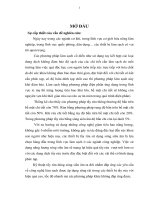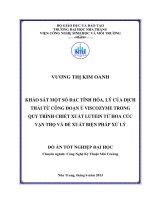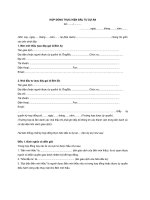chiết xuất rutin từ hoa hoè có sử dụng sóng siêu âm
Bạn đang xem bản rút gọn của tài liệu. Xem và tải ngay bản đầy đủ của tài liệu tại đây (122.72 KB, 3 trang )
Ultrasonics Sonochemistry 8 (2001) 299±301
www.elsevier.nl/locate/ultsonch
The extraction of rutin from ¯ower buds of Sophora japonica
L. Paniwnyk *, E. Beaufoy, J.P. Lorimer, T.J. Mason
School of Natural and Environmental Sciences, Coventry University, Coventry CV1 5FB, UK
Abstract
The eciency of extraction of rutin from Sophora japonica is improved by ultrasound but is dependent on the solvent employed.
Rutin is a compound with antioxidant activity and aqueous solvents appear to be unsuitable for ultrasonic extractions due to the
formation of free radicals from the insonation of the solvent. The application of ultrasound to methanolic extraction gave a signi®cant reduction in extraction time and an increase in maximum yield. Ó 2001 Elsevier Science B.V. All rights reserved.
Keywords: Rutin; Extraction; Ultrasound; Antioxidant
1. Introduction
Renewed interest in plant derived drugs has led to an
increased need for ecient extraction methods. The aim
of this study was to compare conventional and ultrasonic methods for the extraction of the ¯avonoid, rutin
(Fig. 1) from the dried ¯ower buds of the Chinese
Scholar Tree (Sophora japonica) [5].
Flavonoids are products of secondary metabolism in
plants and are of interest to the pharmaceutical and
food industries because of their reported antioxidant
activity [1]. Such compounds can interact with free
radicals and so prevent the damage which radicals might
otherwise cause to cell membranes and biological molecules such as DNA.
Ultrasound has been shown to aid extraction in a
number of plant materials by signi®cantly reducing extraction times and increasing maximum extraction
yields. An example is the extraction of helicid, a Chinese
medicine used in the treatment of fatigue and listlessness, from the dried seeds of Helicid erraticum using
aqueous ethanol [2]. Conventional extraction is usually
performed at re¯ux temperature of 80°C for 2 h. Ultrasonic at 40°C resulted in a yield increase of 50% in the
shorter time of 1 h. Studies on the eect of ultrasound
on the extraction of the main components of sage
(Salvia ocinalis) showed that cineole, thujone and
borneol could be extracted better when sonicated [3].
Many other examples have been reviewed recently [4].
*
Corresponding author.
E-mail address: (L. Paniwnyk).
This observed enhancement of extraction of organic
compounds by ultrasound is attributed to the phenomenon of cavitation produced in the solvent by the
passage of an ultrasonic wave. During the rarefaction
cycle of the sound wave cavitation bubbles are produced
which ®ll with solvent vapour. During the compression
cycle the bubbles and the gas within them are also
compressed resulting in a signi®cant increase in temperature and pressure. This ®nally results in the collapse
of the bubble with a resultant Ôshock waveÕ passing
through the solvent and enhanced mixing occurring.
Ultrasound also exerts a mechanical eect, allowing
greater penetration of solvent into the plant body. This,
coupled with enhanced mass transfer and signi®cant
disruption of cells, via cavitation bubble collapse, has
the eect of releasing cell contents into the bulk medium.
Ultrasound may also produce some chemical eects
due to the production of free radicals within the cavitation bubbles. Sonication of water results in the formation of highly reactive hydroxyl radicals which can
combine to form hydrogen peroxide which may or may
not be bene®cial to the extraction process itself.
2. Results and discussion
Conventional extraction methods using dilute aqueous alkali and methanol as solvents were compared with
ultrasonic extractions in the same solvents. In aqueous
extractions ultrasonic methods were found to give reduced yields when compared with conventional methods
as shown in Fig. 2.
1350-4177/01/$ - see front matter Ó 2001 Elsevier Science B.V. All rights reserved.
PII: S 1 3 5 0 - 4 1 7 7 ( 0 0 ) 0 0 0 7 5 - 4
300
L. Paniwnyk et al. / Ultrasonics Sonochemistry 8 (2001) 299±301
Fig. 1. Structure of rutin.
Fig. 3. Eect of ultrasound on the extraction of rutin from Sophora
japonica using methanol.
during sonication of methanol the extracted rutin is not
degraded.
3. Experimental methods
The conventional and ultrasonic methods employed
are summarised as follows:
3.1. Aqueous extractions
Fig. 2. Eect of ultrasound on the extraction of rutin from Sophora
japonica using water.
The observed reduction in extraction yield is believed
to be the result of degradation of the rutin by interaction
with highly reactive hydroxyl radicals formed during
sonication of the aqueous solvent. The extractions were
therefore carried out in methanol, a solvent which does
not give rise to such a large proportion of radicals under
cavitation. Experiments were performed at room temperature without allowing the temperature to rise since
(a) cavitational eects are reduced as temperature is
increased and (b) although the solubility of rutin in
methanol is much higher than in water over the whole
temperature range the dierence is particularly signi®cant at lower temperatures.
Conventional methanolic extractions gave much
higher yields than aqueous extractions and the yields
were further enhanced by the use of ultrasonic extraction methods as shown in Fig. 3.
The higher yields obtained from conventional methanolic extractions are attributed to the much greater
solubility of rutin in methanol than in water and its
apparent stability to air oxidation in this solvent. The
further increase in yield when ultrasound is applied is
believed to be due to the disruption of cell walls by cavitational eects. Since hydrogen peroxide is not formed
Ten grams of dried ¯ower buds were crushed using a
pestle and mortar and mixed with water (100 cm3 ). The
pH was adjusted to 6±8 using 1 M NaOH and the
mixture was either boiled (for conventional extraction)
or subjected to ultrasound (for ultrasonic extraction)
using a 20 kHz ultrasonic probe (Sonics and MaterialsVC600 with 0.5 in. tip) at 23°C for varying lengths of
time. The mixture was ®ltered and the ®ltrate was
acidi®ed (pH 5±6) using 1 M HCl to precipitate the
rutin and left to stand overnight. The precipitate was
collected by vacuum ®ltration and dissolved in water
and further puri®ed as follows. The pH was adjusted to
6±8 and the solution was boiled for 30 min. It was ®ltered under vacuum and the ®ltrate was acidi®ed and
left to stand overnight. The resulting precipitate was
collected by vacuum ®ltration and dried in an oven at
70°C.
3.2. Alcoholic extractions
Ten grams of dried ¯ower buds were crushed using a
pestle and mortar and mixed with methanol (100 cm3 ).
The mixture was either re¯uxed (for conventional extraction) or subjected to ultrasound (for ultrasonic extraction) using a 20 kHz ultrasonic probe at 23°C for
varying lengths of time. The mixture was ®ltered and the
solvent removed using a rotary evaporator. The residue,
L. Paniwnyk et al. / Ultrasonics Sonochemistry 8 (2001) 299±301
containing rutin alcoholate, was dissolved in water to
convert it into the hydrated form which precipitated
from solution. The mixture was extracted with diethyl
ether to remove chlorophyll and the precipitate in the
aqueous phase was collected by vacuum ®ltration and
dried in an oven at 70°C.
301
Acknowledgements
The authors thank the EC for ®nancial support
(COPERNICUS research program ERB-CIPA-CT940227-1995).
References
4. Conclusions
In any extraction process consideration must be given
to the solubility of the compound being extracted in the
chosen solvent at the extraction temperature employed.
In the cases of compounds with antioxidant activity,
such as rutin, aqueous solvents appear to be unsuitable
for ultrasonic extractions and care must be taken when
employing aqueous solvents in order to avoid degradation of the sample.
The application of ultrasound to the methanolic extraction of rutin from Sophora japonica gave a signi®cant increase in maximum extraction yield.
[1] J.Q. Griths, C.F. Krewson, J. Naghski, Rutin and Related
Flavonoids; Chemistry, Pharmacology and Clinical Applications,
Mack Publishing., Easton, Pennsylvania, 1955.
[2] Y. Zhao, C. Bao, T.J. Mason, A study of the isolation of eective
compositions from traditional Chinese medicinal plants, Ultrasonics International 91 Proceedings, Butterworths, 1991, pp. 87±90.
[3] M. Salisova, S. Toma, T.J. Mason, Comparison of conventional
and ultrasonically assisted extractions of pharmaceutically active
compounds from Salvia ocinalis, Ultrason. Sonochem. 4 (1997)
131±134.
[4] M. Vinatoru, M. Toma, T.J. Mason, Ultrasonically assisted
extraction of bioactive principles from plants and their constituents, In: T.J. Mason (Ed.), Advances in Sonochemistry, vol. 5, JAI
Press, ISBN 0-7623-0331-X, 1999, pp. 209±248.
[5] E. Beaufoy, The extraction of rutin from Sophora japonica Using
Ultrasound, M.Sc. Thesis, Coventry University, 1998.









